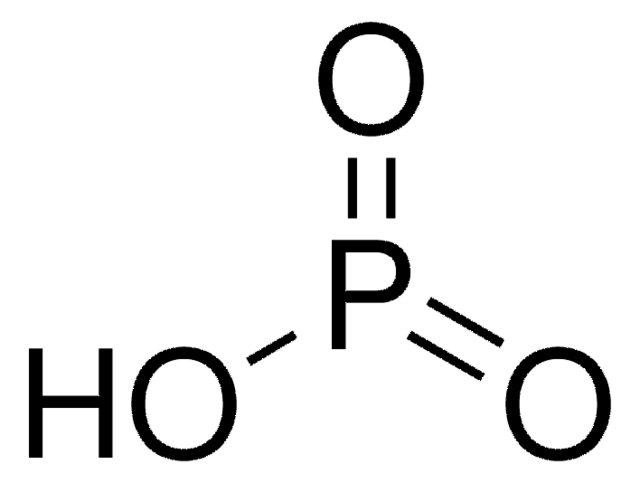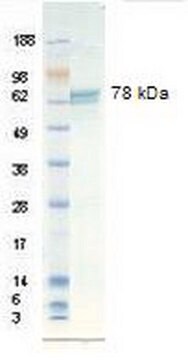Kluczowe dokumenty
239275
meta-Phosphoric acid
ACS reagent, chips, 33.5-36.5%
Synonim(y):
Metaphosphoric acid
About This Item
Polecane produkty
klasa czystości
ACS reagent
Poziom jakości
Postać
chips
zawiera
57.0-63.0% sodium phosphite as stabilizer
stężenie
33.5-36.5%
gęstość
2 g/cm3
ślady anionów
MnO4- reducers: ≤0.02%
chloride (Cl-): ≤0.001%
nitrate (NO3-): ≤0.001%
sulfate (SO42-): ≤0.005%
ślady kationów
As: ≤1 ppm
Fe: ≤0.005%
heavy metals: ≤0.005% (by ICP)
ciąg SMILES
OP(=O)=O
InChI
1S/HO3P/c1-4(2)3/h(H,1,2,3)
Klucz InChI
UEZVMMHDMIWARA-UHFFFAOYSA-N
Szukasz podobnych produktów? Odwiedź Przewodnik dotyczący porównywania produktów
Opis ogólny
Zastosowanie
- A catalyst in combination with InCl3 to synthesize 1,8-dioxooctahydroxanthene derivatives by the reaction of cyclic β-diketones and aldehydes.
- A phosphate precursor to synthesize antimony phosphate (SbPO4) by reacting with antimony metal at high temperatures.
Hasło ostrzegawcze
Danger
Zwroty wskazujące rodzaj zagrożenia
Zwroty wskazujące środki ostrożności
Klasyfikacja zagrożeń
Eye Dam. 1 - Skin Corr. 1
Kod klasy składowania
8B - Non-combustible corrosive hazardous materials
Klasa zagrożenia wodnego (WGK)
WGK 3
Temperatura zapłonu (°F)
Not applicable
Temperatura zapłonu (°C)
Not applicable
Certyfikaty analizy (CoA)
Poszukaj Certyfikaty analizy (CoA), wpisując numer partii/serii produktów. Numery serii i partii można znaleźć na etykiecie produktu po słowach „seria” lub „partia”.
Masz już ten produkt?
Dokumenty związane z niedawno zakupionymi produktami zostały zamieszczone w Bibliotece dokumentów.
Klienci oglądali również te produkty
Nasz zespół naukowców ma doświadczenie we wszystkich obszarach badań, w tym w naukach przyrodniczych, materiałoznawstwie, syntezie chemicznej, chromatografii, analityce i wielu innych dziedzinach.
Skontaktuj się z zespołem ds. pomocy technicznej








